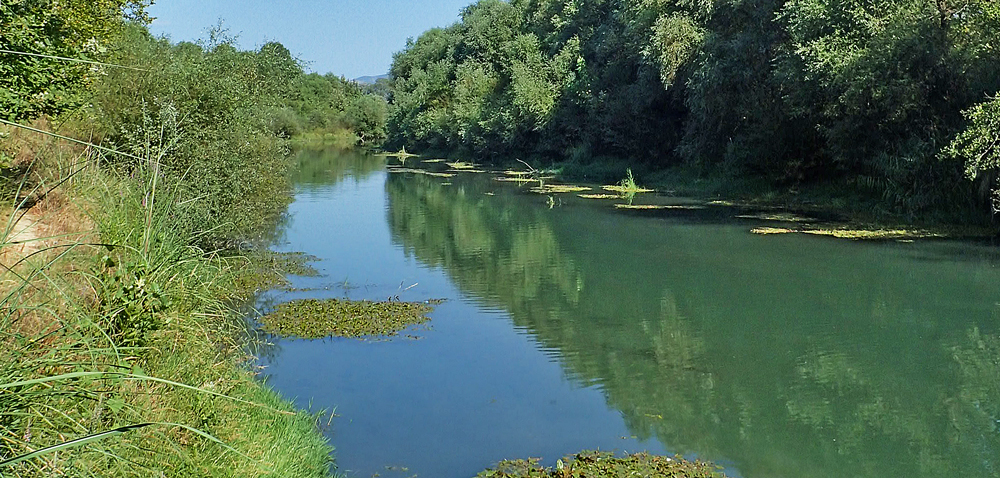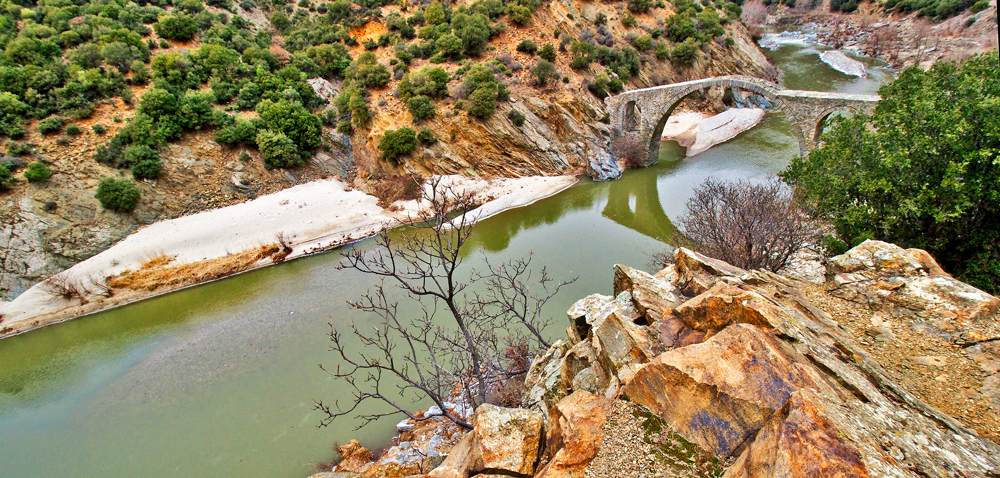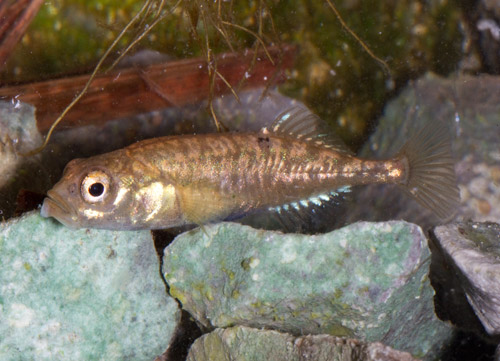Rivers
Sperchios

The imposing river of Central Greece is distinguished for its pristine physiognomy, retaining its ancient course from the springs to its beautiful estuary. Its name originates from the verb “spercho” which means “I move with urge”, while in the years of the Greek Revolution it was also referred to as Alamana. Spercheios springs from Tymfristos mountain, to the east of Central Pindos massif. It runs from west to east and after 82.5 km flows into Maliakos gulf. In its course it creates the great valley of Fthiotida (Valley of Spercheios), which spreads between the mountains of Oiti to the south and Othris to the north. The river basin covers an area of 1,800 square kilometers. Other smaller rivers that descend from Oiti contribute to its waters with the most important being Inachos (Vistriza), Gorgopotamos, Mavroneri and Asopos. Dozens of even smaller streams and torrents end in Sperchios, such as Rustianitis, Katis, Xirias Ypatis, Xirias Lamias, Xirias Vardaton, Voidorema, Maritsa, Mavriliotis, Petsiotis, Kastanorema, Sapounorema, Vaginorema, Dristelorema, Paliochimarorema, Livadorema, Spertorema, Psarofolias, Kavourorema, Kraniorema, Triadafillias, Kakavorema and Gerakaris. Sperchios is an “alive” river than continually change the geomorphology of the area. Since ancient times the river slits have displaced its estuary 8 km into the sea. It is estimated that Maliakos gulf will disappear from the slits of Spercheios within the next thousand years. Sperchios was worshiped as a deity in ancient Greece. Here lived the ancient tribe of the Aenians, here was the heroic battle of Thermopylae against the Persians, the victory of the Byzantines against the Bulgarians in 995, the famous Battle of Alamana and the destruction of the Gorgopotamos bridge during the Nazi occupation. The river was the first border of Greece after the country’s liberation. Today, and if one excludes land reclamation projects for irrigation of the area, Sperchios has not suffered major interventions as most big rivers of Greece. Thus one may observe the true physiognomy of a great river throughout its length. One of the most impressive elements of the river is its vast estuary that creates a large and important habitat for many species of birds.
Throughout its length Sperchios is followed by dense riparian vegetation that consists mainly of willows, oriental planes, poplars, maples, elms, ashes, Jerusalem thorns, turpentines, Judas trees and kermes oaks. In many places, dense and almost inaccessible forests of big alders emerge. At lower Sperchios grow oleanders, tamarisks and chaste trees. Large reeds are spread just before the estuary and near the sea lie huge marshlands with species such as Arthrocnemum macrostachyum, Salicornia perennans, Halimione portulacoides, Salsola soda and Suaeda spledens. Rare plants in the area are Eleocharis parvula and Alkanna calliensis. Near the river grow various plants, such as Allium sphaerocephalon subsp. sphaerocephalon, Centaurea pelia, Epilobium angustifolium, Lythrum salicaria, Equisetum telmateia, Scirpoides holoschoenus, Sideritis purpurea, Acinos suaveolens, Centaurium erythraea subsp. erythraea, Stachys palustris, Arum italicum subsp. italicum, Cirsium arvense, Angelica sylvestris, Prunella laciniata, Epipactis helleborine, Orchis italica, Lactuca viminea subsp. ramosissima, Petrorhagia cretica, Scabiosa tenuis, Carduus pycnocephalus, Silene multicaulis subsp. multicaulis, Hypericum perforatum subsp. veronense and Veronica serpyllifolia subsp. serpyllifolia.
Sperchios attracts dozens species of birds, especially in its large estuary. From the predators here live ospreys, spotted eagles, short-toed eagles, marsh harriers, hen harriers, black kites, common buzzards, peregrine falcons, levant sparrowhawks, common sparrowhawks, lesser kestrels, common kestrels and red-footed falcons. Of the nocturnal predators here live eagle owls, tawny owls, short-eared owls, barn owls, little owls and scops owls. In the shallows of the estuary in winter, many ducks are gathered, such as pintails, shovelers, teals, mallards, common pochards, garganeys, gadwalls and widgeons. In the reeds live 8 species of herons: grey herons, purple herons, little egrets, great egrets, night herons, squacco herons, little bitterns and bitterns. The largest population of avocets in Greece, with over 3,000 individuals, wintering in the estuary. Other wading species are greater flamingos, spoonbills, stone-curlews, kentish plovers, little stints, sandpipers, redshanks, greenshanks, black-winged stilts, ruffs, snipes, collared pratincoles and cormorants. Many species of gulls and terns are found near the sea. Dippers appear in the high reaches of the river. Other species of the area are woodcocks, turtle doves, cuckoos, nightjars, hoopoes, kingfishers, bee-eaters, syrian woodpeckers, skylarks, crested larks, short-toed larks, swallows, red-rumped swallows, tawny pipits, water pipits, meadow pipits, red-throated pipits, grey wagtails, dunnocks, wrens, nightingales, black redstarts, stonechats, blackcaps, sardinian warblers, whitethroats, sedge warblers, moustached warblers, reed warblers, great reed warblers, fantail warblers, Cetti’s warblers, penduline tits, bearded tits, red-backed shrikes, woodchat shrikes, jays, jackdaws, starlings, golden orioles, reed buntings, cirl buntings and corn buntings.
Amphibians include species such as greek newts, common toads, green toads, tree frogs, balkan frogs, greek frogs and agile frogs. Herpetofauna throughout the river is particularly rich and includes species such as balkan pond turtles, pond turtles, Hermann’s tortoises, marginated tortoises, Kotschy’s geckos, Mediterranean house geckos, Balkan green lizards, Erhard’s wall lizards, common wall lizards, Balkan wall lizards, snake-eyed skinks, greek slow worms, glass lizards, worm snakes, smooth snakes, large whip snakes, four-lined snakes, Balkan whip snakes, Dahl’s whip snakes, aesculapian snakes, leopard snakes, grass snakes, dice snakes, levant montpellier snakes and nose-horned vipers. From mammals stands out the constant presence of the otter along the entire length of the river. On the highs of Spercheios appear wolves. The mammalian fauna is complemented by wild boars, foxes, badgers, beech martens, weasels, hedgehogs, various shrews and interesting species of bats, such as barbastelles (Barbastella barbastellus), brown long-eared bats (Plecotus auritus), common bent-wing bats (Miniopterus shreibersii), lesser mouse-eared bats (Myotis blythi) and greater noctule bats (Nyctalus lasiopterus).
The fish fauna of the river is particularly rich. Here live four endemic species: the Greek stickleback (Pungitius hellenicus), the Sperchios barbel (Barbus sperchiensis), the Sperchios perch (Rutilus sp. Sperchios) and Alburnoides economoui. Other species are European eels (Anguilla anguilla), Greek barbels (Luciobarbus graecus), Marathon minnows (Pelasgus marathonicus), Vardar chabs (Squalius vardarensis), rainbow trouts (Oncorhynchus mykiss), western three-spine sticklebacks (Gasterosteus gymnourus), freshwater blennies (Salaria fluviatilis) and Mediterranean toothcarps (Aphanius fasciatus) that live by thousands in the estuary. Finally, it is believed that the mouth of Sperchios is one of the few remaining breeding grounds of meagres (Argyrosomus regius).
Πως θα πάτε
Sperchios is approximately 198 km away from Athens, 305 km from Thessaloniki and only 16 km away from Lamia. The routes that run parallel to the river are plenty. It is worth walking along the paths through the dense alder forests, but also to reach the inaccessible estuary from the area of Agia Triada.Εμφάνιση στο χάρτη
click to see the place on the map(Latitude: 38.894413072798635, Longitude:22.324129910156238)
Social Networks
Also Read

Venetikos
A river that flows between some of the larger rivers of Greece, connects the mountains of Epirus with the plains of Grevena and forms landscapes of great aesthetic value.

Kompsatos
A big river of Thrace, which creates a series of different habitats and hosts many rare species of mammals, birds and freshwater fishes.













